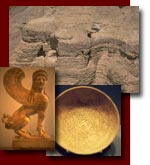| Site Map | Contacts | Links | Newsletter | |
Biblical Archaeology:
Shroud of Turin
'Jesus-Era' Burial Cloth Casts Doubt on Turin Shroud
Discovered in a Jerusalem cemetery known as Akeldama, or "Field of Blood," where Judas Iscariot is thought to have committed suicide, the shroud fragments were found around the remains of a man buried in a sealed chamber. See also Shroud.
The Shroud of Turin is a Fake! The first recorded evidence of the Shroud of Turin is in 1357 AD in France; far removed from the time of Christ. Joe Nickell in his book Inquest into the Shroud of Turin, tells about a bishop's report to Pope Clement that told how the cloth was used in a healing scam to defraud pilgrims, and its image had been "cunningly painted" by a confessed artist. Nickell states that the image is similar to French gothic paintings. There is a lack of wraparound distortions and "blood" flows that are "picture like" and still bright red, not dull as real blood would be (See Nichell's book).
Secondly, In 1973 forensic tests for blood on the Shroud of Turin turned up negative.
Thirdly, after analyzing samples from the Shroud microanalyst Walter McCrone discovered that both image and so called blood areas had been painted by an artist using a red ocher and vermilion tempera paint. There are pictures of this at his web site, see Latest Shroud Update.
Fourthly, in 1978 examinations were done by STURP (Shroud of Turin Research Project). They claimed the image was anatomically correct, yet Nichcell states that the footprint does not match with the leg's position, the hair falls as if standing, not lying down, and the whole body is unnaturally long similar to Gothic art.
Fifthly, In 1988 samples of the Shroud were radiocarbon dated by three independent labs which dated the Shroud between 1360 and 1390 AD. A Team in Texas led by Leoncio A. Garza-Valdes have questioned these results, but the origin of their samples have been challenged. The Archbishop of Turin, Cardinal Giovanni Saldarini, has publicly challenged the sample's authenticity, and he says that he and the Vatican "declare that they cannot recognize the results of the claimed experiments." Walter McCrone, who has "examined thousands of fibers from 32 different areas of the 'Shroud,'" contends that the fibers shown in the team's photomicrographs "did not come from the 'Shroud' of Turin." (For more details see New "Shroud" Claims Challenged as Spurious.
Garza-Valdez has claimed to have found human DNA supposedly of Jesus. He wrote The DNA of God? (1999). The Vatican has refused to authenticate his samples. Anyone who has touched the shroud, cried over it, or a hair has fallen on it, can leave traces of human DNA on the shroud.
Garza-Valdez also claimed that a microbial coating on the shroud altered the radiocarbon date. Physicist Thomas Pickett calculated that would have to be twice as much contamination, by weight, as the cloth itself (see Sketical Inquirer September/October 2001 and Skeptical Briefs, June 1996).
It has been claimed by Max Frei-Sulzer that he has found pollen on the shroud that only comes from Palestine. Max has a bad reputation. He claimed to be a handwriting expert who said the "Hitler diaries" were genuine when they were exposed as forgeries. He has also been found guilty and censured by the Police hierarchy in Switzerland. STURP's tape samples show few pollen samples. Only one single tape had many pollen spores in one small area indicating the tape had been contaminated. Schafersman publicly proclaimed that Max was guilty of deception (Sketical Inquirer September/October 2001, 19).
There was a story circulated that the radiocarbon dating was done on a patch from the 1532 AD fire causing a late date, but this is totally false. Dmitrii Kuznetsov, a Russian scientist claimed that the heat from the fire of 1532 could alter the dating, but others could not replicate his results because his calculations had been plagiarized complete with an error (Wilson 1998, 219-223).
A retired psychiatrist, Alan Whanger and his wife have claimed to see all sorts of amazing things in the shroud like plant images, Roman coins, nails, a hammer, pliers, two scourges, two brush brooms, coil of rope, a cloak with a belt, sandals, Roman dice and much more. This is like finding shapes in the clouds.
Most importantly, the New Testament in John 19:40 states, "Then took they the body of Jesus, and wound it in linen clothes with spices." Note that the body was wound around in linen clothes (plural). The shroud is one cloth with no marks of being wound. John 20:6-7 states "Then cometh Simon Peter following him, and went into the sepulchre, and seeth the linen clothes lie, and the napkin, that was about his head, not lying with the linen clothes, but wrapped together in a place by itself." There was a napkin around Jesus' head, not a one piece shroud. The question is whether to believe the Gospel of John or not.
